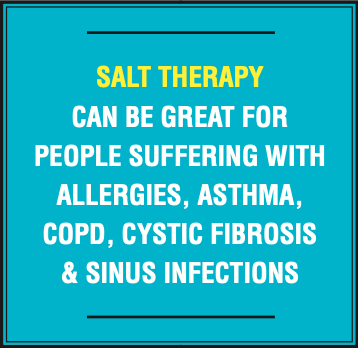Sometimes a spa day is all you need for a day of relaxation, both physically and mentally. But some innovative spa therapies actually can benefit other aspects of health.
Two popular therapies include visiting specialty rooms that may have health benefits by breathing in either heated or salted air. This includes the more traditional sauna rooms and the newer salt rooms.
Sauna rooms work by emitting heat—in temperatures ranging between 150 degrees to 195 degrees Fahrenheit— that penetrates the skin and works to relax muscles. A 2015 study published in JAMA Internal Medicine reported that regular visits to a sauna may be associated with lower death rates from cardiovascular disease and stroke. Indeed, experts at Harvard Health say that saunas can lower blood pressure and widen blood vessels.
Sauna rooms may not be for everyone. Check with your doctor if you are planning on using a sauna room especially if you have high blood pressure, heart problems, diabetes, are pregnant or may become pregnant. If sauna rooms are given the okay, people should still be careful with how they use sauna therapy.
Harvard Health warns to stay only for 10-15 minutes, cool down gradually while ingesting at least two cool glasses of water a day, and never visit a sauna after alcohol use or while taking medicine that may prevent perspiration or produce overheating.
On the other hand, salt rooms are a “relatively” new therapy to U.S. consumers as they have begun to pop up in more communities recently. In fact, salt therapy is not new at all. The American Lung Association reports that a 1943 Polish physician observed that salt mine workers did not experience the respiratory problems or incidence of lung disease like coal miners.
Salt has been used in health therapies for many years—in scrubs, solutions and baths. The advent of halotherapy, salt rooms, began in Europe and has spread worldwide. A salt room is where a generator releases 99.9% pharmaceutical grade sodium chloride into the atmosphere in tiny microns.
“Guests breathe in this salt which then aids in breaking up mucus in the air ways and sinus cavities.
This is also anti-inflammatory which makes salt therapy great for people suffering with allergies, asthma, COPD, cystic fibrosis, sinus infections, etc. The particles are also so tiny they aid with skin issues like psoriasis, eczema, acne, etc.,” said Megan Forcey, owner of Relax Salt Rooms in Gainesville.
Relax Salt Room features a salt room for adults with 17,000 pounds of imported Himalayan salt on the walls and floor. Guests visit for 45-minute sessions where they circulate the same amount of salt in the air in 45 minutes that someone would get being at the beach for 72 hours straight breathing in the beach air. A children’s salt room helps kids with breathing or skin issue. These 30-minute sessions feature a room with beach toys they can play with in the salt.
Forcey does warn that people understand it’s not an instant fix.
“Just like medication and exercise, our bodies are not just fixed by doing salt therapy just one time. If a guest has on going issues like severe allergies or asthma, it may take several sessions to get to a point where they only need it weekly or monthly,” Forcey said.
The American Lung Association agrees that salt therapy can be beneficial by “pushing fine salt particles through the air that are inhaled, which fall on the airway linings and draw water into the airway, thinning the mucus and making it easier to [break up], thus making people feel better.”
Just like with sauna therapy, the American Lung Association does recommend checking with your doctor before visiting a salt room to make sure this therapy is right for you.
Related articles:
Finding Gratitude: The Secret To Life
Healthy Ways To Deal With Holiday Anxiety And Stress
Stop Social Media Scrolling To Improve Your Mental Wellness
Get 10,000 Steps In A Day – The Easy Way!
What Is Cardamom And How Do You Use It?


